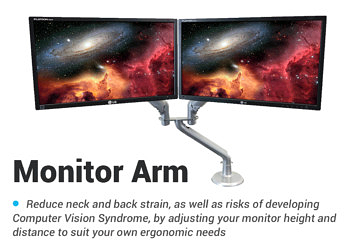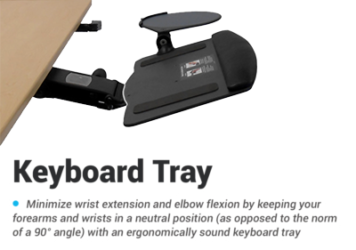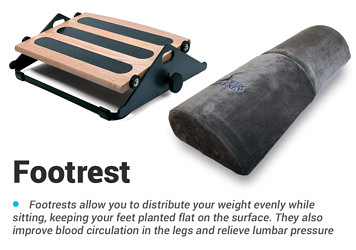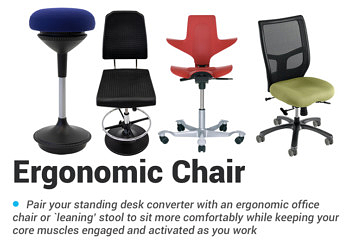What to Choose: Standing Desk vs. Sit-Stand Converter?
- Must Read
Like most reviews sites, our editorial staff and laboratory testing expenses are partially offset by earning small commissions (at no cost to you) when you purchase something through those links. Learn More

Every month we have thousands of readers researching these very questions on our websites, so we thought it time to dedicate an article to the discussion. Should you get a standing desk or sit-stand converter? When is it best to move aside your old desk, replacing it wholesale with a new sit-stand desk? And when does it make more sense to keep your old desk and place a sit-stand converter on top of it?
First, the reasons for choosing a new desk:

1. You plan to use a walking treadmill–if not now, then potentially in the future. In this scenario it’s all about safety and stability, not to mention decor—no one wants something looking like a Rube Goldberg contraption in their office. If you’re going to build a standing/walking workstation—and in particular if you’re going to get all three modalities out of one desk (sitting, standing and walking), you’re going to want a standing desk with sufficient height range (at least 50″–and the more the better), sufficient width, and a built-in keyboard tray for the best ergonomics, stability, and style. There are few standing desk converters with the vertical reach and stability to work well as part of a walking workstation (e.g. ZipLift), but you’d absolutely want to securely clamp them to the desk for safety reasons. It’s best to stick with a good standing desk if you’re contemplating working while walking.
2. You need a lot of desk surface area. A very common complaint about standing desk converters is that they can take up the center of your desk but lack a sufficiently large working surface (free of monitors, keyboard, mouse, etc.) for all your papers. If you’re standing, you don’t want to reach down from afar to grab papers. So having an entire desk come up or down to your level is a big bonus. The caveat here is that “hover style” standing desk converters—such as the Cadence Plus, Cadence Express, Quickstand Lite, ESI Climb, and Ergotron Workfit-A—can be moved out of the way with a light push, giving you back access to virtually your entire desktop, at least when sitting. When standing, you’d still need to reach down to your papers.
3. You want the most stable experience. To be sure, there are also cheap standing desks on the market that wobble ridiculously as you type. Always check out our reviews first before getting razzled and dazzled by slick photos and marketing copy. But as a general rule, height-adjustable desks will give you an overall better experience in terms of monitor shake. If you’re building an ergonomic workstation that means you’re also adding a monitor arm, and any vibration in the desk will be transmitted to and amplified by the monitor arm, particularly if you use a heavy monitor or set of monitors. So stability is king, and you’ll definitely want to check out our comparative standing desk reviews to pick the most solid desk you can find in your budget range.
That said, most—though certainly not all—standing desk converters are going to be a bit shaky. Of course, there’s a spectrum of stability in these units as well, but paying more doesn’t always guarantee a more stable platform. In fact, the most stable of all, the ZipLift, is a relatively inexpensive $359 device, while the least stable, the Quickstand, costs twice as much. Most units under $299, and certainly the many cheap, gimmicky, Chinese-made products you’ll find for under $100 on Amazon, are going to make you feel like a leaf on a tree in a late October breeze. Check out our comprehensive standing desk converter reviews to learn more about each model’s pros and cons.

4. You want real ergonomics. Let’s be blunt. A standing desk converter will always be a compromise of some degree when it comes to ergonomics. Typical deficiencies for many of them are no tilting adjustment in the keyboard platform and no ability to mount an ergonomic keyboard tray, the inability to mount a good monitor arm, and general instability that causes your hands to tense up when trying to avoid a typo. At the risk of sounding like a broken record, read our reviews first, to find out which ones are going to score highest on ergonomic adjustability (several of them are really good, to be sure). The point is, when you buy a standing desk you know that there’s at least going to be a solution, at least 95% of the time, for setting up a good keyboard tray and monitor arm to complete the workstation. The 5% to avoid? Those that have no way of mounting a keyboard tray and those that are too thick to install a monitor arm.
Now, the reasons for a sit-stand converter:

1. You have a built-in desk. Unless you’re willing to do a little DIY work or get a contractor in to remove a section of your built-in counter, you have no other option. Note: many people who work in cubicles are unaware that their desktop surfaces can easily be pulled out, often without even breaking out a toolbox. See our round-up of the best compact standing desk models, with their shallower desktops that are highly popular in cubicle scenarios such as these. Also note that if you’re going to try to position your standing desk converter into the corner of your cubicle, look for models with tapered back corners for the ideal fit. Take careful measurements to make sure your standing desk converter of choice will fit properly and work with your monitors, computer, and keyboard setup.
2. Your desk is a cherished heirloom and you don’t want to stop using it. Hey, we get it. Our only advice then is to make sure to select a standing desk converter that won’t damage the finish on your desktop.
3. You don’t want to lose your file drawer space. If you need to frequently access your drawers when sitting or standing at your desk, we totally get that, too. However, be aware there are more and more standing desk storage options becoming available.
Completing Your Ergonomic Workstation
Acquiring the best standing desk for your decor, budget and performance requirements is Step One. But making it a true ergonomic workstation involves adding the appropriate accessories you’ll need to keep your body in a correct posture, and have a neat and tidy setup. Check out our comprehensive guides to monitor arms, keyboard trays, anti-fatigue mats, ergonomic seats, cable management kits, power management modules, foot rests and under-desk treadmills for both expert advice and lab-tested product reviews of options in each of these categories.
Need more help? Read how to find your correct desk height, then check out 10 ways to improve your office ergonomics and answers to the most common standing desk questions.





0 Comments
Leave a response >